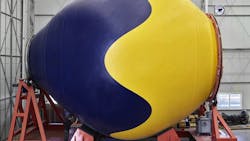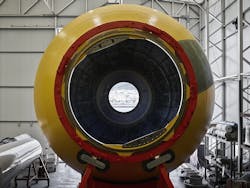CorPower delivers composite wave energy converter hull
Offshore staff
CorPower has teamed up with composite machinery specialist Autonational and composite tank experts CPT Tankwell to successfully develop its first commercial-scale hull in Viana do Castelo (Portugal), using a custom-built machine, installed inside an environmentally controlled work cell.
The composite hull forms an integral part of CorPower's next-generation C4 WEC.
Over the last year, process characterization work on quarter-scale models has enabled rapid iterations and continuous tuning to reach targeted quality and material properties reviewed by DNV as a certification body, which CorPower says has paved the way for final commercial scale construction.
Completed at CorPower's Portuguese base in Viana do Castelo, it marks an important milestone in the flagship HiWave-5 Project, which will involve ocean deployment in nearby Aguçadoura.
“This has been a tremendous team effort involving our specialist composite team in Portugal and Sweden with close cooperation with our local and global supply chain partners.” said Miguel Silva, managing director with CorPower Ocean Portugal. “The C4 hull has been designed with a low-cost sandwich structure comprising of filament-wound composite skins for the inner and outer layer separated by a core material. This approach brings a raft of benefits including high strength, durability and impact resistance combined with lightweight and buoyancy performance properties, which can withstand fatigue, slamming and impact loads. Other important features include excellent adhesion strength and chemical resistance with low water absorption.”
The hull construction has been carried out in conjunction with dry-testing of CorPower's PTO (Power Take Off) system, using the world’s largest wave energy test rig, according to the company.
In its entirety, the composite hull development work cell consists of a fully customized filament winding machine situated on a 14-m-long base. This includes an automated carrying system to apply fibers onto a 9-m diameter mandrel, to wind the hull layer-by-layer.
Tord Jonsson, supply chain and quality manager, said, “Based on the R&D-cell in Viana do Castelo, future versions of such manufacturing cells can be easily integrated in port or final assembly facilities, amounting to mobile factories. This will enable composite hulls to be built rapidly on customer sites, with additive manufacturing dramatically reducing lead times, cost and carbon footprint by eliminating transportation of the finished product. Delivering wave farms to our customers, we will be moving these factory cells from site the site, to produce the hulls needed for a project, then move the cells over to the next customer site. The equipment will be packed and transported in three standard containers, taking only a few days to assemble once delivered to a new site. Our mobile factory concept enables high local content in projects and will play a key role in revitalizing local port communities and local supply chains.”
Working in collaboration with several utility companies, CorPower's first commercial-scale C4 WEC will be used to form part of a larger four-system array and one of the world’s first wave farms generating energy to the national grid.
07.25.2022

